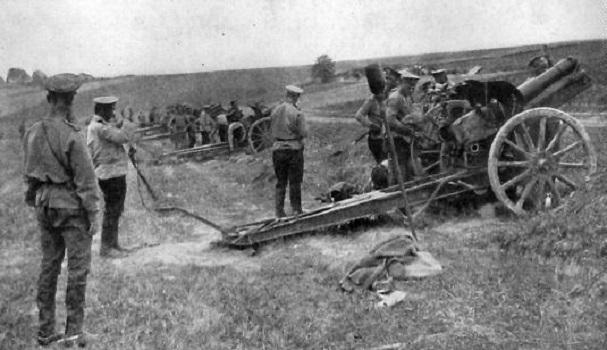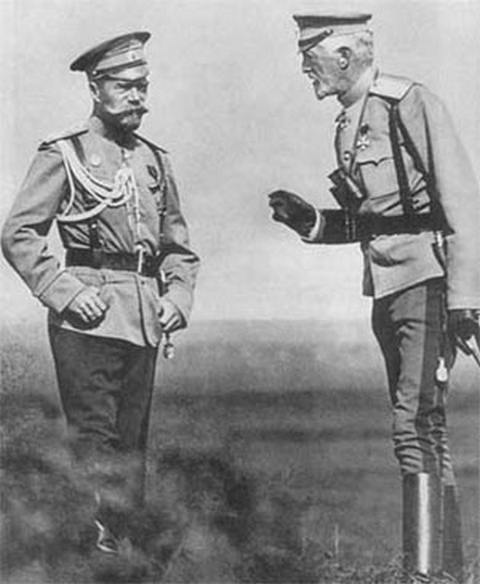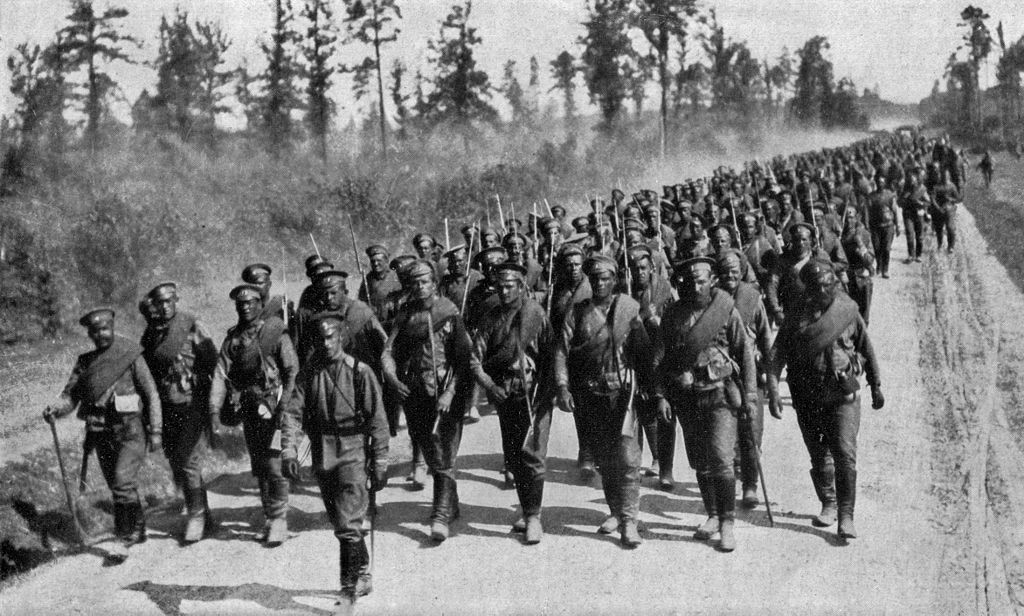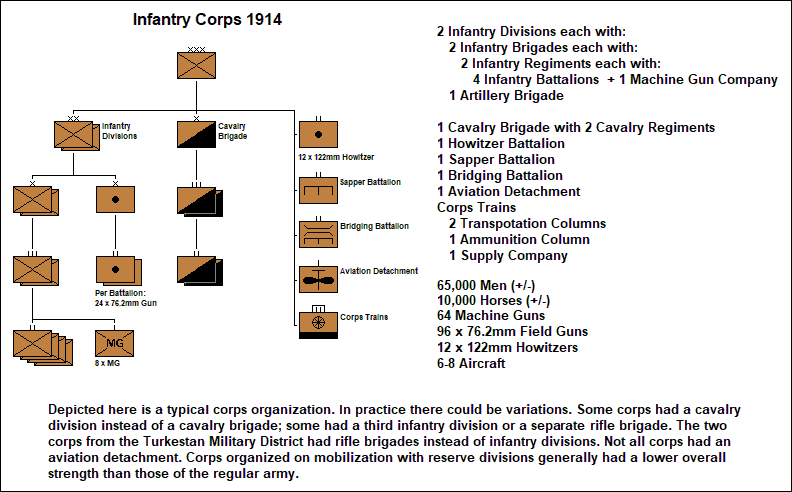|
● ● ●
In August 1914 the Russian Army mobilized well
over three million men in 115 infantry divisions, 24 cavalry
divisions, 17 rifle brigades and 8 cavalry brigades—a force that was
to grow substantially as reservists were recalled to the colors and
new units were raised.
The Army's basic combat formation was the
army corps, usually consisting of two infantry divisions, a
cavalry division or brigade, an artillery howitzer battalion, a
sapper battalion, a bridging battalion, a supply battalion and an
aviation detachment. The infantry division consisted of a
headquarters company, two infantry brigades and an artillery
brigade. Each infantry brigade controlled two infantry regiments;
the artillery brigade had two battalions, each with three batteries
of field guns. By modern standards the infantry division's support
services were minimal. On campaign a company of the corps sapper
battalion and perhaps a squadron of cavalry were detached to each
infantry division, but supply and communications troops were
controlled by the corps and field army headquarters. Cavalry
divisions had a similar organization—two cavalry brigades each with
two cavalry regiments—but instead of an artillery brigade they had
only one battalion of horse artillery.
A field army—nine were constituted upon
mobilization—consisted of three to five army corps plus heavy
artillery, engineer, supply, transport and aviation units. The
senior field headquarters was the front (army group), controlling a
variable number of armies. During the war the principal fronts were
Northwest Front (against Germany) Southwest Front (against
Austria-Hungary) and Caucasus Front (against Turkey).

Command Flag of the XI Army Corps (Graphic by Tom
Gregg)
Contrary to legend, the Russian Army in 1914
was reasonably well equipped with small arms (including eight
machine guns per infantry regiment) and field artillery. The standard
76.2mm field gun was an excellent weapon of its type and each
infantry division had 48 of them. But the lack of light and medium
field howitzers capable of high-angle fire was a serious deficiency.
The infantry divisions had none and most army corps had only one
artillery howitzer battalion with twelve 122mm howitzers. Heavy
artillery suitable for use in the field was also in short supply;
only a few corps had a heavy artillery battalion with 152mm
howitzers and 107mm long-range guns. Against the Austro-Hungarian
Army, which had a similar artillery deficit, this did not matter
very much, but against the better-prepared German Army it was to
prove a major handicap.
More serious still was the ammunition
situation. Prewar planning had greatly underestimated the rate at
which ammunition—artillery ammunition in particular—would be
expended in battle. Existing stocks were quickly consumed in the
1914 campaign and new production was unable to keep up with demand.
Most ammunition was manufactured in state-owned factories and there
had been no serious planning for the conversion of civilian industry
to war production. Consequently the Russian Army suffered a chronic
shortage of ammunition. Production of rifles, machine guns and
artillery was also insufficient to both replace losses and arm newly
raised divisions. These problems were gradually solved, but by the
time they were the Russian Army had already suffered crippling
losses and the country was moving toward revolution.
The shell shortage, as it came to be called, did prove useful in
one respect, serving Russian commanders as a convenient alibi for
defeat. After each disaster the cry went up for ever more guns and
shells—enough to pulverize the enemy's defenses. And the failure to
provide munitions in the quantities demanded enabled the generals to
shift the responsibility onto the government. In fact, however, the
shortage of weapons and munitions, though real enough, was never so
serious that it could not have been compensated for by careful
planning and appropriate tactics. But this, unfortunately, was
easier said than done.
For another problem that bedeviled the Russian
Army was a shortage of trained staff officers, noncommissioned
officers and technical troops. Most conscripts and reservists were
illiterate peasants: hardy, obedient, patriotic and brave but
difficult to train in any but the most rudimentary military duties.
It was particularly hard to find sufficient men for those service
branches requiring formal education and technical qualifications,
such as the artillery, engineers, signal corps, railway troops, air
service, etc. And in sharp contrast to the well-educated,
well-trained noncommissioned officer corps of the German Army,
Russian NCOs were usually not much better educated than the men they
led. As a result, crude battlefield tactics exacerbated by poor
staff work regularly turned defeats into debacles. The field
artillery, which considered itself the elite branch of the service,
was disdainful of the infantry—"cattle" in the opinion of artillery
officers—and coordination between them was generally poor. In
many cases the artillerymen simply pulled out of action when things
began to go wrong, saving their guns but leaving the infantry in the
lurch.

A Russian howitzer battery in action
(Imperial
War Museum)
This shortage of trained and qualified
personnel also set limits on the wartime expansion of the army.
Peasant manpower was available in plenty, but it was exceedingly
difficult to find the necessary officers and technical specialists
to make newly raised reserve divisions effective. The mid-war
shortage of weapons and ammunition only compounded the problem. In
combat against the Germans, these poorly trained units tended to
fare badly, falling to pieces or simply evaporating in the face of a
coordinated attack.
All these factors conspired to limit the
Army's combat effectiveness. Against the Austrians and Turks the
Russian Army proved more than capable of holding its own, but
against the Germans its deficiencies resulted in a succession of
costly and demoralizing defeats.
Further exacerbating the Russian Army’s
problems was the confusion of Stavka, the high command. In peacetime
there had been no overall army headquarters. Upon mobilization
Stavka was hastily botched together and in the opening round it
failed to exert firm control over the field armies. The primary
culprit was factionalism. The Army’s senior officers were split
between two groups: the “Northerners” who believed that the Army
should make its main effort against Germany, seen as the main enemy,
and the “Southerners” who favored making the main effort against
Austria-Hungary, seen as easier to defeat. In hindsight it appears
that the Southerners had the better argument: Austria-Hungary's
defeat would fatally have undermined Germany's position. But nothing
was done to implement this strategy nor, indeed, to develop any sort
of overall strategy.

Tsar Nicholas II (left) and his uncle, Grand Duke Nicholas
(Imperial War Museum)
The commander-in-chief, Grand Duke
Nicholas—the Tsar’s uncle—was a much-admired figure but even his
prestige in the Army was ineffective in resolving this dispute over
strategy. So the Russian Army found itself fighting what were
virtually two separate
wars against Germany and Austria-Hungary, to the accompaniment of
much wrangling over the allocation of reserves, replacements and
supplies. The two army groups—Northwest Front against Germany and
Southwest Front against Austria-Hungary—seldom coordinated their
action and Stavka, which was supposed to enforce such coordination,
was largely ignored. Thus victories over the Austrians in 1914 and
1916 could not be fully exploited: Northwest Front proved reluctant
to part with reserves for the benefit of its rival, Southwest Front.
But the string of defeats it suffered at the hands of the Germans,
culminating in the loss of the Polish salient, essentially paralyzed
Northwest Front. Controlling the larger part of the forces on the
Eastern Front, it did nothing—and its paralysis proved fatal for
Russia.
Whether a properly coordinated strategy,
defensive against Germany, offensive against Austria-Hungary, would
have produced better results for Russia is an interesting but
doubtful question. Of all the major belligerents, tsarist Russia was the
one most susceptible to civil unrest and revolutionary turmoil under
the shock and stress of war. What is certain is that the
non-strategy actually pursued invited needless defeats while
throwing away hard-won victories, driving the country toward
breakdown and revolution. So perhaps, just perhaps, a coherent
strategy, imposed by an effective high command, might have staved
off disaster. But given Russian realities in 1914, it’s difficult to
see where such a strategy and such a high command could have come
from.
● ● ●
|





